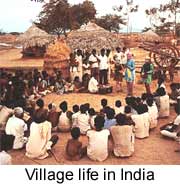

 |  |
People and Population. About 16 per cent of all the world's people live in India. Only China, which has a population of more than one billion, has more people than India.  India is more densely populated than most other countries. India is more densely populated than most other countries.Vital statistics:
Since the early 1900's, India's population has grown by several million a year. During the 1980's and 1990's, the population increased by as much as 18 million per year. The main reason for this "population explosion" is that improved sanitation and health care have caused the death rate to fall more rapidly than the birth rate. Population growth has led to serious overcrowding. India's city population grows about twice as fast as the population of the country as a whole. Ancestry. India's people belong to a variety of ethnic groups. The two largest groups are the light-skinned Indo-Aryans and the dark-skinned Dravidians. Most Indo-Aryans live in northern India, and a majority of the Dravidians live in southern parts of the country. The Dravidians were among India's earliest known inhabitants. About 2500 B.C., they created an advanced civilization in the Indus Valley. About 1500 B.C., the Aryans invaded the Indus Valley and drove the Dravidians south. Beginning about A.D. 1000, central Asian Islamic peoples, mainly from the area that is now Afghanistan and Iran, settled in India. Many of their descendants live in the northeast, especially in the states of Bihar, Uttar Pradesh, and West Bengal. Mongoloid peoples live in the Himalayan region along India's northeastern border and in the states that border Burma. Most members of such minority groups as the Bhils, Gonds, Khasis, Nagas, Oraons, and Santals live in remote hills and forests. Continue....... |
Copyright ©2000 indiansaga.info. All rights reserved.
By using this service, you accept that you won't copy or use the data given in this website for any commercial purpose.
The material on indiansaga.info is for informational & educational purpose only.
This site is best viewed at 800 X 600 picture resolution.